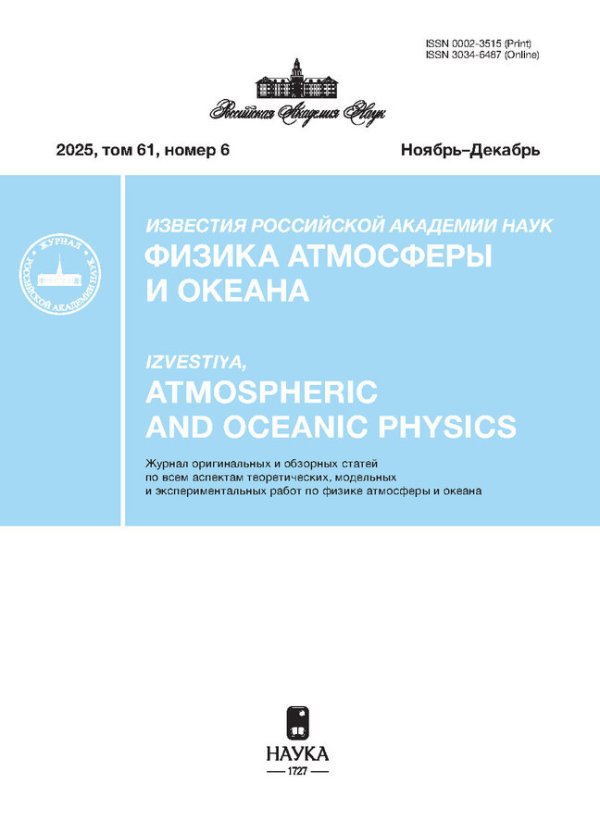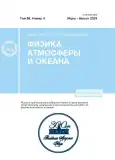On the Influence of Atmospheric Ions on Aerosol Formation: Numerical Modeling
- Authors: Aloyan A.E.1, Yermakov A.N.2, Arutyunyan V.O.1
-
Affiliations:
- Marchuk Institute of Numerical Mathematics, Russian Academy of Sciences
- Institute of Energy Problems of Chemical Physics, Russian Academy of Sciences
- Issue: Vol 59, No 4 (2023)
- Pages: 467-473
- Section: Articles
- URL: https://journals.rcsi.science/0002-3515/article/view/136934
- DOI: https://doi.org/10.31857/S000235152304003X
- EDN: https://elibrary.ru/YMVGXF
- ID: 136934
Cite item
Full Text
Abstract
A new mathematical model of the global transport of multicomponent gas impurities and aerosols has been constructed, including the formation of sulfate aerosols in the atmosphere in both hemispheres. Calculations of the nucleation rates and particle number concentrations were performed for the winter period in the troposphere using a unified model that takes into account chemical and kinetic transformation processes (photochemistry, nucleation, condensation/evaporation, and coagulation). Binary nucleation of sulfuric acid and water vapor was coupled with new-particle formation due to atmospheric ions. The numerical results indicate a significant role of ion nucleation in aerosol formation in the Northern and Southern hemispheres in winter. The factors controlling the dynamics of ionic processes in the atmosphere and their influence on the spatiotemporal distribution of aerosol particles involve not only the level of air ionization but also temperature, relative humidity, and the content of sulfur and water vapor in the air. At a height of 4.2 km, the formation of particle nuclei with the participation of ions occurs only over the Lake Baikal and Kamchatka regions as well as the regions of the northeast and northwest of the American continent. Within the regions of localization of this process in the atmosphere, the rate of new particle generation varies by more than an order of magnitude.
Keywords
About the authors
A. E. Aloyan
Marchuk Institute of Numerical Mathematics, Russian Academy of Sciences
Author for correspondence.
Email: ezmakr2010@yandex.ru
Russia, 119333, Moscow, ul. Gubkina, 8
A. N. Yermakov
Institute of Energy Problems of Chemical Physics, Russian Academy of Sciences
Author for correspondence.
Email: polclouds@yandex.ru
Russia, 119334, Moscow, Leninskii pr., 38, bild. 2,
V. O. Arutyunyan
Marchuk Institute of Numerical Mathematics, Russian Academy of Sciences
Email: polclouds@yandex.ru
Russia, 119333, Moscow, ul. Gubkina, 8
References
- Алоян А.Е. Моделирование динамики и кинетики газовых примесей и аэрозолей в атмосфере. М.: Наука, 2008. 415 с.
- Алоян А.Е., Ермаков А.Н., Арутюнян В.О. Формирование сульфатных аэрозолей в тропосфере и нижней стратосфере // Исследование возможной стабилизации климата с помощью новых технологий. М.: Росгидромет, 2012. С. 75–98.
- Алоян А.Е., Ермаков А.Н., Арутюнян В.О. Аэрозоль в верхней тропосфере и нижней стратосфере. Сульфатные частицы в северных широтах // Оптика атмосферы и океана. 2018. Т. 31. № 2. С. 136–142.
- Akimoto H. Atmospheric Reaction Chemistry, Springer, 2016.
- Aloyan A.E. Mathematical modeling of the interaction of gas species and aerosols in atmospheric dispersive systems // Russ. J. Num. Anal. Math. Model. 2000. V. 15(1–4). P. 211–224.
- Aloyan A.E., Yermakov A.N., Arutyunyan V.O. Modeling the influence of ions on the dynamics of formation of atmospheric aerosol // Izv. Atmos. Ocean Phys. 2021. V. 57. № 1. P. 104–109.
- Ferguson E.E. Ion–molecule reactions in the atmosphere // Kinetics of Ion–Molecule Reactions, Ed. by P. Ausloos, Springer, Boston, 1979. P. 377– 403.
- Froyd K.D., Lovejoy E.R. Experimental thermodynamics of cluster ions composed of H2SO4 and H2O. 1. Positive ions // J. Phys. Chem. A 2003. V. 107. № 45. P. 9800–9811.
- Hofmann D.J. Measurement of the concentration nuclei profile to 31 km in the Arctic in January and comparison with Antarctic measurements // Geophys. Res. Lett. 1990. V. 17. № 4. P. 357–360.
- Kirkby J., Curtius J., Almeida J. et al. Role of sulphuric acid ammonia and Galactic cosmic rays in atmospheric aerosol nucleation // Nature. 2011. V. 476. P. 429–433.
- Kurihara Y., Televa R.E. Structure of tropical cyclone developed in three-dimensional numerical simulation model // J. Atmos. Sci. 1974. V. 31. № 5. P. 893–919.
- Kusaka I., Wang Z.-G., Seinfeld J.H. Ion-induced nucleation: A density functional approach // J. Chem. Phys. 1995. V. 102. № 2. P. 913–924.
- Lowe D., MacKenzie R. Review of polar stratospheric cloud microphysics and chemistry // J. Atmos. Sol.-Terr. Phys. 2008. V. 70. № 1. P. 13–40.
- Yu F. Ion-mediated nucleation in the atmosphere: Key controlling parameters, implications, and look-up table // J. Geophys. Res. 2010. V. 115. D03206.
- Yu F., Luo G., Bates T.S. et al. Spatial distributions of particle number concentrations in the global troposphere: Simulations, observations, and implications for nucleation mechanisms // J. Geophys. Res. 2010. V. 115. D17205.
- Zuend A. and Seinfeld J.H. Modeling the gas-particle partitioning of secondary organic aerosol: the importance of liquid-liquid phase separation // Atmos. Chem. Phys. 2012. V. 12. № 9. P. 3857–3882.
Supplementary files

















